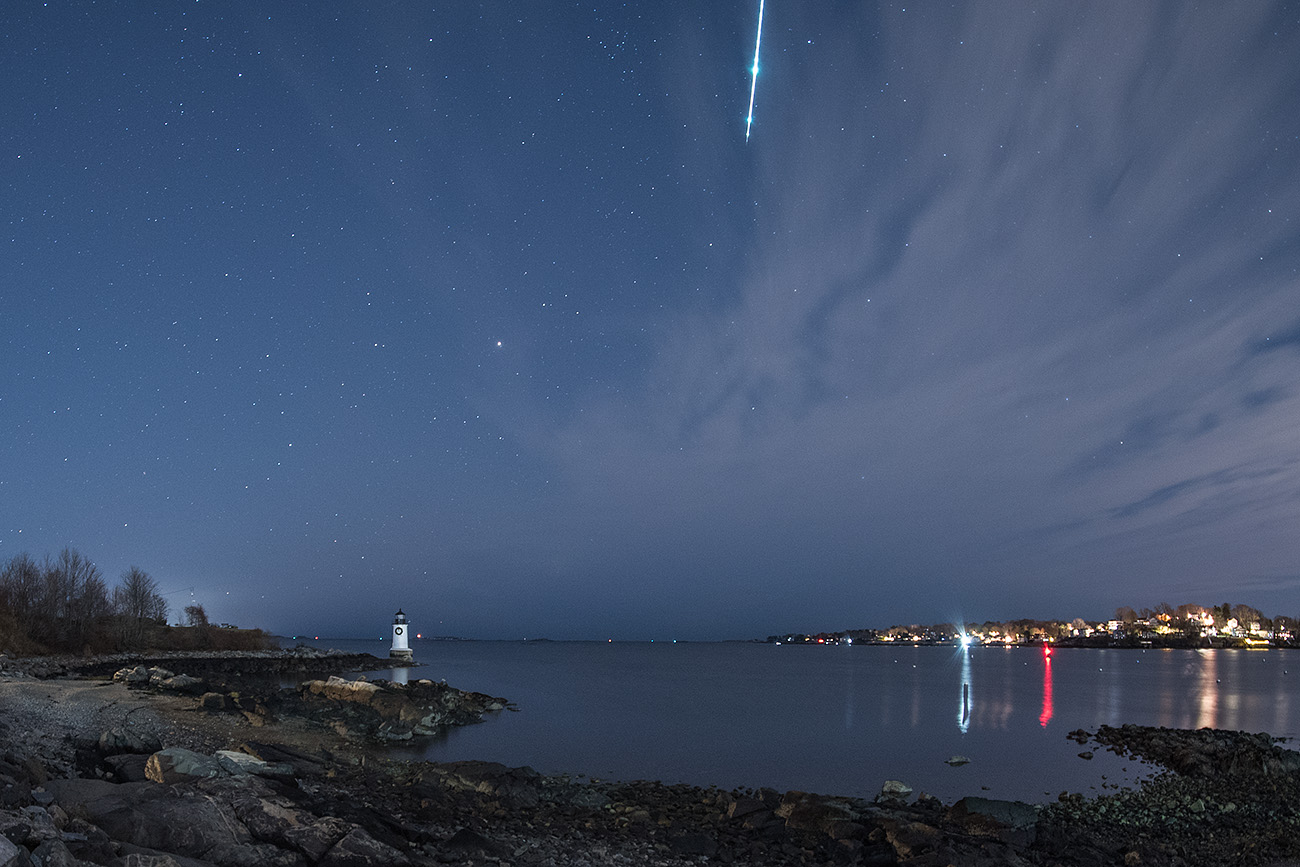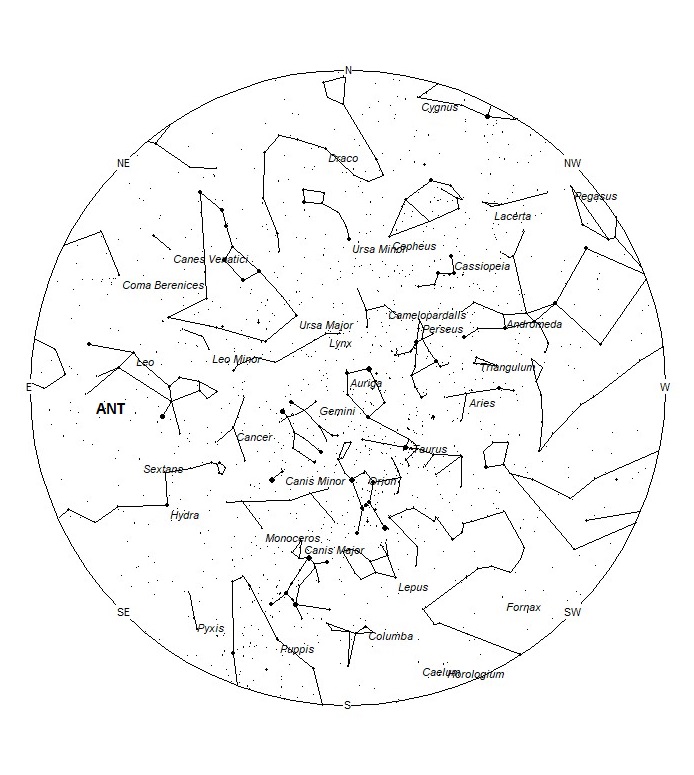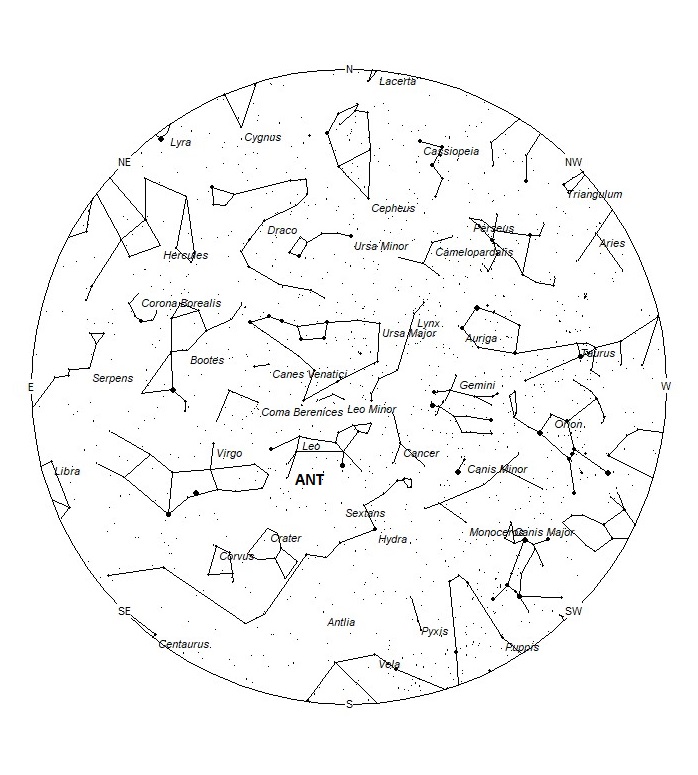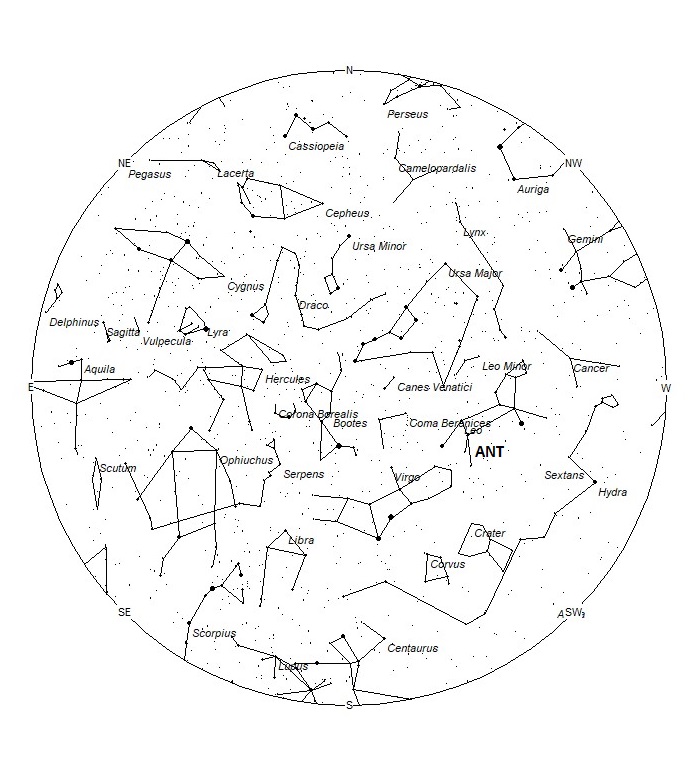 Rick Matthias captured this double bursting fireball on December 14, 2021 at 3:38 EST (8:38 UT) from Salem, Massachusetts, USA. This was most likely a member of the Geminid meteor shower, which peaked in intensity that morning. ©Rick Matthias
Rick Matthias captured this double bursting fireball on December 14, 2021 at 3:38 EST (8:38 UT) from Salem, Massachusetts, USA. This was most likely a member of the Geminid meteor shower, which peaked in intensity that morning. ©Rick MatthiasDuring this period, the moon reaches its last quarter phase on Wednesday February 23rd. At that time the moon lies 90 degrees west of the sun and rises near 01:00 local standard time (LST). This weekend the waning gibbous moon will rise during the evening hours and will spoil the sky for meteor viewing the remainder of the night. The estimated total hourly meteor rates for evening observers this week is near 2 no matter your location. For morning observers, the estimated total hourly rates should be near 3 as seen from mid-northern latitudes (45N) and 6 as seen from tropical southern locations (25S). The actual rates will also depend on factors such as personal light and motion perception, local weather conditions, alertness, and experience in watching meteor activity. Rates during this period are reduced due to strong moonlight. Note that the hourly rates listed below are estimates as viewed from dark sky sites away from urban light sources. Observers viewing from urban areas will see less activity as only the brighter meteors will be visible from such locations.
The radiant (the area of the sky where meteors appear to shoot from) positions and rates listed below are exact for Saturday night/Sunday morning February 19/20. These positions do not change greatly day to day so the listed coordinates may be used during this entire period. Most star atlases (available at science stores and planetariums) will provide maps with grid lines of the celestial coordinates so that you may find out exactly where these positions are located in the sky. I have also included charts of the sky that display the radiant positions for evening, midnight, and morning. The center of each chart is the sky directly overhead at the appropriate hour. These charts are oriented for facing south but can be used for any direction by rotating the charts to the desired direction. A planisphere or computer planetarium program is also useful in showing the sky at any time of night on any date of the year. Activity from each radiant is best seen when it is positioned highest in the sky, either due north or south along the meridian, depending on your latitude. It must be remembered that meteor activity is rarely seen at the radiant position. Rather they shoot outwards from the radiant, so it is best to center your field of view so that the radiant lies at the edge and not the center. Viewing there will allow you to easily trace the path of each meteor back to the radiant (if it is a shower member) or in another direction if it is sporadic. Meteor activity is not seen from radiants that are located far below the horizon. The positions below are listed in a west to east manner in order of right ascension (celestial longitude). The positions listed first are located further west therefore are accessible earlier in the night while those listed further down the list rise later in the night.
This source of meteoric activity is expected to be active this week.
Details of each source will continue next week when viewing conditions are more favorable
You can keep track of the activity of these meteor showers as well as those beyond the limits of visual observing by visiting the NASA Meteor Shower Portal available at: https://meteorshowers.seti.org/ You can move the sky globe to see different areas of the sky. Colored dots indicate shower meteors while white dots indicate sporadic (random) activity. The large orange disk indicates the position of the sun so little activity will be seen in that area of the sky.
| SHOWER | DATE OF MAXIMUM ACTIVITY | CELESTIAL POSITION | ENTRY VELOCITY | CULMINATION | HOURLY RATE | CLASS |
| RA (RA in Deg.) DEC | Km/Sec | Local Standard Time | North-South | |||
| Anthelion (ANT) | — | 10:56 (164) +07 | 30 | 01:00 | 1 – 1 | II |
 American Meteor Society
American Meteor Society



I spotted a long lasting trail of something burning up in the atmosphere tonight, Saturday the 19th of February, 2022, looking south towards Miami, Florida. It was heading from west to east and lasted 4/5 seconds
Hey just so let you know , I saw an asteroid feb 19 2023 , exactly 1 year later you saw the asteroid. I was driving to Detroit from Cincinnati, around 9pm est , I witnessed a greenish blue line in the sky for a second.
Highway 24 towards Clarksville, saw a bright light
Meteor hit very fast
Something burning up in the atmosphere tonight over Portugal about 16 degrees east of south. Lasted 3 seconds, fireball shape but I doubt from experience that it was a meteor.
My husband and I saw something in the night sky at 7:22pm yesterday, Feb 21, 2022. We were driving westbound and saw a big ball falling towards the south of us. I’ve never seen anything like it before, so I have no idea what it was, if it was even a meteorite or something else entirely.
My husband saw it too!! In Southeast Arizona Coronado National Park near Aravaipa Canyon.
Seen a meteorite breaking up in the atmosphere heading in the south direction on February 21/21 in Northern Alberta.
Saw a meteor on 23 Feb at 10.10pm in Somerset West, Cape South Africa. It was traveling from north east in a south west direction. It was brilliant orange and had a loooooong tail of almost solid orange! It seemed very low in the sky and I watched it for at least 2 seconds if not longer.
spotted a meteor at 23:00 over NYC out of all places on Feb 23rd 2022 – One big ball with a trailing flame went from west to east
I have seen a shooting star like object moving fast on 24 feb 2022, at night time, in Trivandrum, Kerala, India. It was brighter and larger than other stars and disappeared before reaching horizon. It lasted for almost 10 seconds.
I Saw a long bright white trail of perhaps a meteorite in the sky heading from west to east. It lasted a good 6 or 7 seconds and faded very slowely. It was a white line in mid air, from where I was sitting it was about 40 cm long. I was driving on the N59 (Schaapsweg to A29) in the Netherlands at 05:45 AM on February 23, 2022
Saw on with my daughter last night( 27th February) in Orsholtz, Germany. Low down on sky, bright for around 4 seconds or so…
I saw one with my daughter last night( 27th February) in Orsholtz, Germany. Low down in sky, bright for around 4 seconds or so…